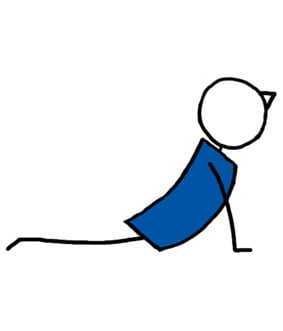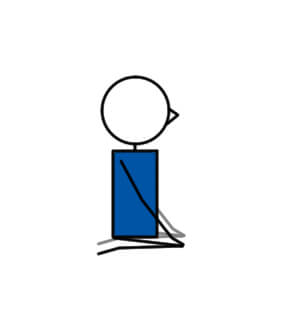
| Category: | Yoga Lesson Planner |
|---|---|
| Sub Category: | Seated & Floor |
| Types: | Seated & Floor, Stretch, Supine |
| Anatomy: | Arms & Shoulders, Wrists & Arms |
| Chakras: | Heart Centre, Solar Plexus Centre |
| Therapy: | Poor Posture |
| Drishti: | Up |
| Dosha: | Pitta, Vata |
| Meridian Lines: | Bladder, Kidney, Spleen, Stomach |
Lie on your back. Maintain the small-of-back curve throughout the exercise. Place a hand-sized rolled towel there for optimal spinal alignment. Knees bent. Hands by ears. 1. Inhale. 2. Exhale, lower upper arms and forearms towards the mat. 3. Inhale, and raise arms. 4. Exhale, lower arms again.
Increases flexibility and range of motion for your pecs. Release tension from chest muscles. Improves posture.
If your head tilts back while lying down, use folded towels for support, but avoid excess.
Knee or neck injury.
Click here for lots of FREE downloadable Yoga lesson plans.
Click here for lots of FREE downloadable Pilates lesson plans.
Pec Minor Stretch FAQs
What are the benefits of a pec stretch?
Let’s talk about the magical world of the Pec Stretch. You know, those chest muscles that can get tighter than your favourite pair of skinny jeans after a big meal. This stretch is your trusty sidekick to help release that tension and make you feel like a superhero with an expansive, powerful chest.
Picture this: you’ve been hunched over your desk all day, typing away like a caffeinated squirrel. Your pecs are crying out for some sweet, sweet relief! Enter the pec stretch. It helps improve your posture, making you stand tall and proud. And let’s not forget, that Mr Pec Stretch also increases flexibility and range of motion, helping you reach for that top-shelf snack like a ninja.
So, the next time you’re feeling stiff and constricted, remember your trusty pec stretch. It’s like your chest’s best friend.
What are the Pec Minor teaching steps?
Lie on your back. Maintain the small-of-back curve throughout the exercise. Place a hand-sized rolled towel there for optimal spinal alignment. Knees bent. Hands by ears. 1. Inhale. 2. Exhale, lower upper arms and forearms towards the mat. 3. Inhale, and raise arms. 4. Exhale, lower arms again.
What are some Pec Minor pose modifications?
Here are some modifications to make the exercise more accessible and comfortable:
Knee support: If you have any discomfort in your lower back or hips, place a bolster or folded blanket under your knees to provide extra support (helps to maintain the natural curve of the lower back).
Reduced arm movement: If you have a shoulder or neck issue, modify the arm movement by placing your hands on your chest instead of by your ears. As you breathe, gently move your hands outward in a slow, controlled motion, and then bring them back to your chest.
Head support: If using folded towels doesn’t feel comfortable or stable, try using a yoga block under your head for increased support.
Arm position variation: If lowering and raising your arms feels too challenging or causes discomfort, try placing your hands on your hips, keeping your elbows bent at a 90-degree angle. Inhale and exhale as you gently press your elbows towards the mat and release.
Slow and steady: Focus on moving through the exercise at a slower pace, allowing your body to adjust and get familiar with your range of motion. Take longer, deeper breaths to help you relax and ease into the stretch.
What’s a good counter pose?
Most yoga teachers will get their students in the Knees To Chest pose, or Knees To Head pose.
5 Interesting Facts to help you Become Aware of Why it’s Essential to Give the Pecs a Good Stretch
Here are a few interesting facts to help you understand why it’s essential to give them a good stretch:
The pecs are actually two muscles: The pectoralis major, which is the larger and more visible one, and the pectoralis minor, a smaller muscle hidden beneath it. Together, they play a crucial role in the movement and stability of your upper body.
Pecs are multitaskers: These muscles help with various tasks like lifting, pushing, and even something as simple as opening a door. They’re involved in everyday activities and are essential for upper body strength.
They form your posture: Tight pecs can pull your shoulders forward, causing a rounded or hunched posture. Stretching the pecs helps to counteract this effect, promoting better alignment and a more upright, confident stance.
Protect your rotator cuff: Tight pecs can limit your shoulder’s range of motion and put extra strain on the rotator cuff. Keeping your pecs flexible and well-stretched helps to reduce the risk of shoulder injuries and discomfort.
Breath support: The pectoralis minor plays a role in the movement of your ribcage during deep breaths. Stretching the pecs can improve your breathing capacity, making it easier to take full, expansive breaths during your yoga practice and daily life.




 Yoga Lesson Planner
Yoga Lesson Planner
 Pilates Lesson Planner
Pilates Lesson Planner


















